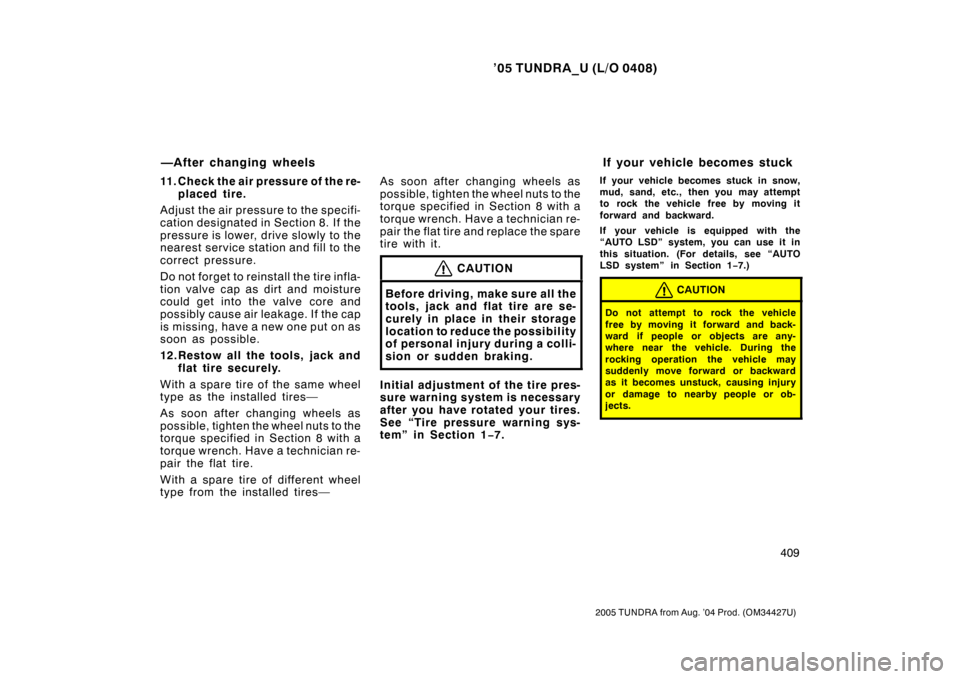Page 420 of 506

’05 TUNDRA_U (L/O 0408)
409
2005 TUNDRA from Aug. ’04 Prod. (OM34427U)
11. Check the air pressure of the re-
placed tire.
Adjust the air pressu re to the specifi-
cation designated in Section 8. If the
pressure is lower, drive slowly to the
nearest service station and fill to the
correct pressure.
Do not forget to reinstall the tire infla-
tion valve cap as dirt and moisture
could get into th e valve core and
possibly cause air leakage. If the cap
is missing, have a new one put on as
soon as possible.
12.Restow all the tools, jack and flat tire securely.
With a spare tire of the same wheel
type as the installed tires—
As soon after changing wheels as
possible, tighten the wheel nuts to the
torque specified in Section 8 with a
torque wrench. Have a technician re-
pair the flat tire.
With a spare tire of different wheel
type from the installed tires— As soon after changing wheels as
possible, tighten the wheel nuts to the
torque specified in Section 8 with a
torque wrench. Have a technician re-
pair the flat tire and replace the spare
tire with it.
CAUTION
Before driving, make sure all the
tools, jack and flat tire are se-
curely in place in their storage
location to reduce the possibility
of personal injury during a colli-
sion or sudden braking.
Initial adjustment of the tire pres-
sure warning system is necessary
after you have rotated your tires.
See “Tire pressure warning sys-
tem” in Section 1−
7.
If your vehicle becomes stuck in snow,
mud, sand, etc., then you may attempt
to rock the vehicle free by moving it
forward and backward.
If your vehicle is equipped with the
“AUTO LSD” system, you can use it in
this situation. (For details, see “AUTO
LSD system” in Section 1 −7.)
CAUTION
Do not attempt to rock the vehicle
free by moving it forward and back-
ward if people or objects are any-
where near the vehicle. During the
rocking operation the vehicle may
suddenly move forward or backward
as it becomes unstuck, causing injury
or damage to nearby people or ob-
jects.
—After changing wheels If your vehicle becomes stuck
Page 460 of 506

’05 TUNDRA_U (L/O 0408)
449
2005 TUNDRA from Aug. ’04 Prod. (OM34427U)
For vehicles with vehicle stability
control system—
�Do not use tires of different
brands, sizes and construc-
tions. This may damage the
drive system and prevent the
vehicle stability control system
from functioning correctly.
Toyota recommends all four tires,
or at least both of the front or rear
tires be replaced at a time as a set.
S ee “I f you hav e a fl at tire” in Section
4 for tire change procedure.
When a tire is replaced, the wheel
should always be balanced.
An unbalanced wheel may affect ve-
hicle handling and tire life. Wheels
can get out of balance with regular
use and should therefore be balanced
occasionally.
When replacing a tubeless tire, the
air valve should also be repl aced
w i t h a new on e. Initial adjustment of the tire pres-
sure warning system is necessary
after you have rotated your tires.
See “Tire pressure warning sys-
tem” in Section 1−
7.
With a spare tire of the same
wheel type as the installed tires
Rotating tires
Page 461 of 506

’05 TUNDRA_U (L/O 0408)
450
2005 TUNDRA from Aug. ’04 Prod. (OM34427U)
With a spare tire of different
wheel type from the installed
tires To equalize the wear and help ex-
tend tire life, Toyota recommends
that you rotate your tires accord-
ing to the maintenance schedule.
(For scheduled maintenance infor-
mation, please refer to the “Sched-
uled Maintenance Guide” or “Own-
er’s Manual Supplement”.)
However, the most appropriate tim-
ing for tire rotation may vary ac-
cording to your driving habits and
road surface conditions.
See “If you have a fl
at tire” in Section
4 for tire change procedure.
When rotating tires, check for uneven
wear and damage. Abnormal wear is
usually caused by incorrect tire pres-
sure, improper wheel alignment, out −
of −balance wheels, or severe braking.
Initial adjustment of the tire pres-
sure warning system is necessary
after you have rotated your tires.
See “Tire pressure warning sys-
tem” in Section 1− 7.
WHEN TO USE SNOW TIRES OR
CHAINS
Snow tires or chains are recommended
when driving on snow or ice.
On wet or dry roads, conventional tires
provide better traction than snow tires.
SNOW TIRE SELECTION
If you need snow tires, select tires of
the same size, construction and load
capacity as the originally installed tires.
Also, on four−wheel drive models, all
the tires must be the same brand and
have the same tread patterns.
Do not use tires other than those men-
tioned above. Do not install studded tires
without first checking local regulations for
possible restrictions.
Installing snow tires and
chains
Page:
< prev 1-8 9-16 17-24